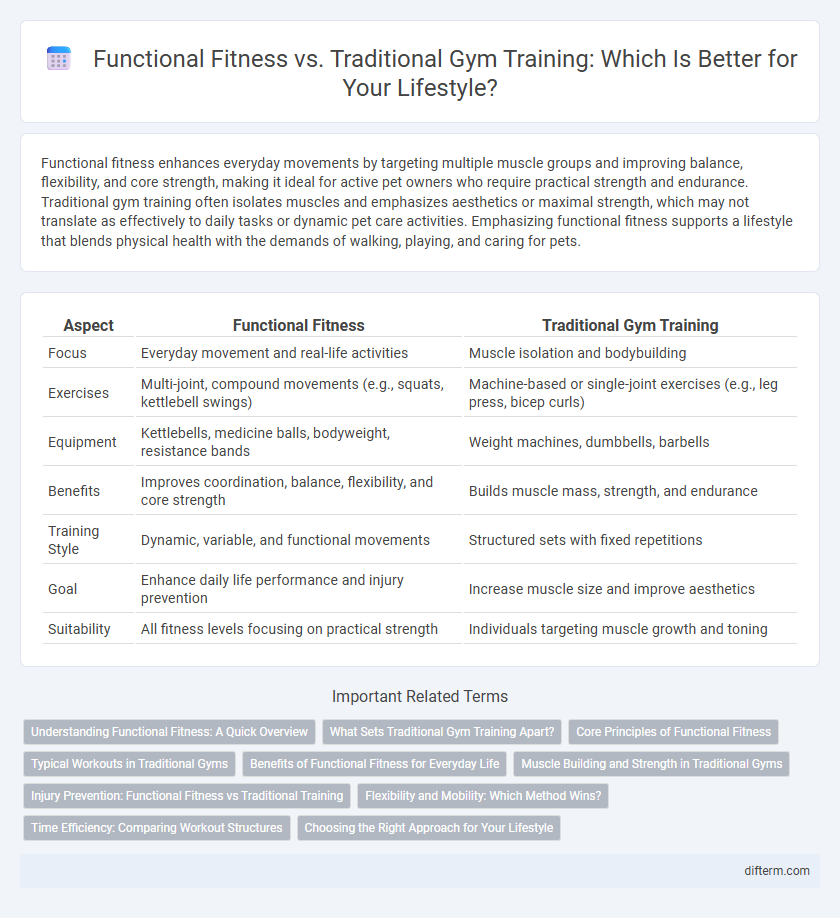Functional fitness enhances everyday movements by targeting multiple muscle groups and improving balance, flexibility, and core strength, making it ideal for active pet owners who require practical strength and endurance. Traditional gym training often isolates muscles and emphasizes aesthetics or maximal strength, which may not translate as effectively to daily tasks or dynamic pet care activities. Emphasizing functional fitness supports a lifestyle that blends physical health with the demands of walking, playing, and caring for pets.
Table of Comparison
| Aspect | Functional Fitness | Traditional Gym Training |
|---|---|---|
| Focus | Everyday movement and real-life activities | Muscle isolation and bodybuilding |
| Exercises | Multi-joint, compound movements (e.g., squats, kettlebell swings) | Machine-based or single-joint exercises (e.g., leg press, bicep curls) |
| Equipment | Kettlebells, medicine balls, bodyweight, resistance bands | Weight machines, dumbbells, barbells |
| Benefits | Improves coordination, balance, flexibility, and core strength | Builds muscle mass, strength, and endurance |
| Training Style | Dynamic, variable, and functional movements | Structured sets with fixed repetitions |
| Goal | Enhance daily life performance and injury prevention | Increase muscle size and improve aesthetics |
| Suitability | All fitness levels focusing on practical strength | Individuals targeting muscle growth and toning |
Understanding Functional Fitness: A Quick Overview
Functional fitness emphasizes exercises that mimic real-life movements to improve overall strength, balance, and coordination essential for daily activities. Unlike traditional gym training, which often isolates muscle groups with machines and fixed routines, functional fitness incorporates dynamic, multi-joint exercises that enhance natural body mechanics. This approach reduces injury risk and boosts performance in everyday tasks by training the body as an integrated system rather than in isolated parts.
What Sets Traditional Gym Training Apart?
Traditional gym training emphasizes isolated muscle exercises using machines and free weights, promoting targeted strength development. It offers structured workout routines guided by trainers, enhancing technique and progression. This approach appeals to individuals seeking measurable gains and a controlled environment for fitness improvement.
Core Principles of Functional Fitness
Functional fitness emphasizes natural movement patterns and full-body engagement to improve everyday mobility and strength, contrasting with traditional gym training's isolated muscle focus. Core principles include multi-joint exercises, balance, coordination, and adaptability to real-life activities. This approach enhances overall functional performance, reduces injury risk, and supports long-term health.
Typical Workouts in Traditional Gyms
Typical workouts in traditional gyms often emphasize isolated muscle exercises such as bench presses, bicep curls, and leg presses aimed at hypertrophy and strength gains. These routines frequently involve machines and free weights targeting specific muscle groups rather than integrated movements. The focus remains on repetitive sets and reps designed to build muscle mass and improve endurance within controlled movement patterns.
Benefits of Functional Fitness for Everyday Life
Functional fitness training enhances everyday life by improving strength, balance, and mobility through movements that mimic daily activities. This workout style reduces injury risk and promotes better posture, making routine tasks easier and safer. Unlike traditional gym training, functional fitness emphasizes multi-joint exercises that activate multiple muscle groups simultaneously for practical, real-world benefits.
Muscle Building and Strength in Traditional Gyms
Traditional gym training is highly effective for muscle building and strength development due to access to specialized weight machines, free weights, and progressive overload techniques. It allows targeted muscle isolation and hypertrophy through structured routines, maximizing muscle fiber recruitment and growth. Consistent resistance training in traditional gyms enhances neuromuscular adaptation, increases muscle mass, and significantly improves overall strength.
Injury Prevention: Functional Fitness vs Traditional Training
Functional fitness emphasizes natural movement patterns that improve balance, flexibility, and core strength, reducing the risk of common gym injuries such as strains and joint stress. Traditional gym training often isolates muscle groups with repetitive motions, which can increase injury risk by creating muscular imbalances and overuse. Prioritizing functional exercises tailored to everyday movements promotes safer, more sustainable fitness progress and enhances overall injury prevention.
Flexibility and Mobility: Which Method Wins?
Functional fitness emphasizes dynamic movements that enhance flexibility and joint mobility by mimicking real-life activities and engaging multiple muscle groups simultaneously. Traditional gym training often isolates muscles through fixed equipment, which can improve strength but may limit overall mobility and range of motion. For sustained flexibility and improved functional movement, functional fitness provides a more effective approach by prioritizing full-body coordination and adaptive mobility.
Time Efficiency: Comparing Workout Structures
Functional fitness workouts prioritize compound movements that engage multiple muscle groups simultaneously, significantly reducing overall workout time. Traditional gym training often involves isolated exercises targeting specific muscles, which can extend session duration and increase rest periods. Emphasizing time efficiency, functional fitness offers a streamlined approach by combining strength, flexibility, and cardiovascular training into shorter, more impactful routines.
Choosing the Right Approach for Your Lifestyle
Functional fitness emphasizes movements that improve everyday activities by targeting multiple muscle groups and enhancing balance, coordination, and flexibility. Traditional gym training often focuses on isolated muscle strengthening and hypertrophy through machines and free weights, which may be preferred for bodybuilding goals. Selecting the right approach depends on individual lifestyle needs, such as prioritizing practical mobility and injury prevention with functional fitness or pursuing aesthetic and strength gains within traditional gym routines.
Functional Fitness vs Traditional Gym Training Infographic

 difterm.com
difterm.com